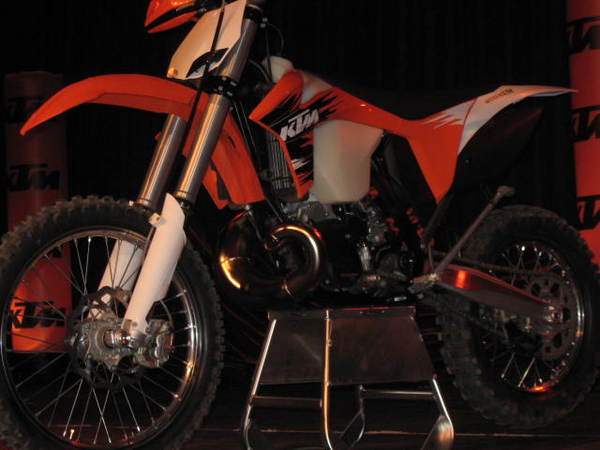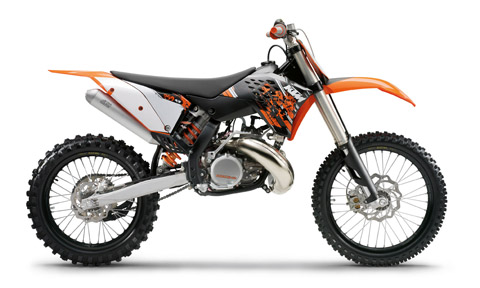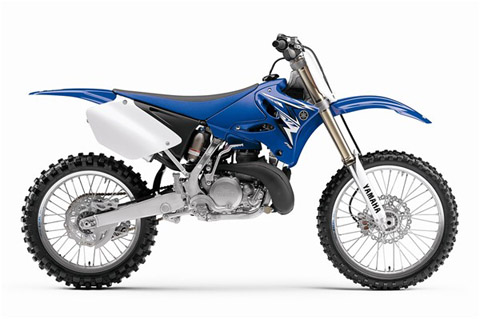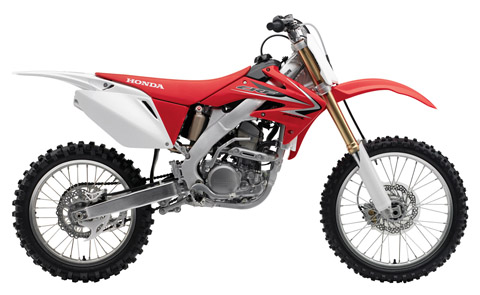The February 2009 issue of Dirt Bike magazine contains a shootout between a Honda CRF250R, Yamaha YZ250 and KTM 250SX. That’s right a shootout between the king of the four stroke 250Fs and a pair of modern day two-strokes from Yamaha and KTM.
The following is the complete test retyped for your enjoyment. (Thanks Scooter42)
The rules are a mess. Back in the two-stroke days, someone decided that four-strokes needed a displacement advantage to be competitive. Those days are long gone, but the skeleton of that old set of rules remains, and there’s no consistency from one club to another. Some rules have 144cc two-strokes racing against 250cc four-strokes, others have 250s against 250s, and other clubs just don’t care because there are so few two-strokes on the start line.
Here’s what will happen: the distinction between two-stroke and four-stroke will eventually wither away. It’s already happening in the amatuer racing world, and for the first time in years, the two-stroke market is showing signs of life. Both Yamaha and KTM remain committed to the two-stroke and continue with year-to-year model updates. Beyond that, KTM reports that two-strokes are it’s biggest sellers, although primarily off-road bikes.
That’s why we’re here. We took the two most current 250cc two-strokes on the market, the KTM 250SX and the Yamaha YZ250, and compared them to the top bike in the four-stroke world, the Honda CRF 250R. We already know that the CRF will demolish a 125 two-stroke. We already know that the CRF has an edge on a 144cc two stroke as well. But those rules are going, going, gone. In a straight-up battle of 250s, does the most current technology of the 250F trump the power advantage of the 250 two-stroke?
KTM 250SX
KTM has continued to develop the two-stroke all this time, getting lighter and more powerful every year. The 250SX is not a huge seller, but it benefits from the development of the monstrously popular 300 off-road bike. The 2009 SX already had a great motor, and KTM left it alone with it’s case reed motor. The suspension got much more significant changes, starting with a redesigned WP shock. The bike has not shock linkage, instead relying on progressive damping to stiffen things up before bottom. Now that system uses a longer needle to do it’s job well as a revamped bottoming system. The fork has new tubes with different flex characteristics.
One of the most interesting aspects of the bike is the fact that it gives you options. First of all, there’s a milder curve preprogrammed in the ignition that can be accessed by unplugging a wire. There are also a number of power-valve springs that come with the bike, color coded for different stiffness. For the record, we installed the most aggressive spring (the red one) for this test. And if you want to change the fork offset you don’t need new clamps, you can simply press out the elliptically mounted steering head stem and reverse it. All cool things.
Yamaha YZ250
Last year was a tough year for dirt bike sales everywhere, but for Yamaha, almost all of the decrease was on the two-stroke side. Still, the YZ250 was considered the best of the lot and Yamaha was committed to keeping it. It got a few changes for the new season but the bike remains as a snapshot of motocross technology as it stood about four years ago. The last time it saw major revision was the aluminum frame in 2005. Back then two-strokes were still on top of most forms of racing and the YZ250 had just earned the Supercross championship.
Beyond its reputation as the best 250MX two-strokes, the YZ250 earned a legendary spot in off-road racing. Barry Hawk, Jason Raines and a long list of champions insisted that the YZ was the best bike ever made for hard-core racing in tight woods. It was never meant to be an off-road bike, of course, but that might be the biggest demographic for the bike these days.
Honda CRF250R
In the real battle of the 250s, we have to include the current king. The Honda CRF250R won the 2009 Dirt Bike 250F shootout. It also won the 2008 version. It’s the biggest seller, and it’s a perfect example of where technology has taken the 250F. In this contest, it stands to defend al four-stroke honor.
While the other two bikes have inched forward in recent years, the 250 four-stroke has changed radically. The most telling aspect is the weight. At 215 pounds, the Honda is actually lighter than the YZ250 by a smidgeon. How is that possible? It’s all a matter of priority. If Honda (or Yamaha) had sunk this much development into a two-stroke, it would almost certainly be under 200 pounds.
The Honda CRF250R has a conventional carburetor, of course, but the new FCR represents the absolute peak of carburetor technology, whereas the 38mm Keihin carbs on the two-strokes have been around for a long time. Even in chassis technology, the CRF250R is a benefactor of the latest, greatest stuff available, like the Honda Progressive Steering Damper System.
Sorting It Out
In the battle of two-stroke motors, the Yamaha and the KTM were more equally matched than we thought. We have come to expect anything with a KTM motor to expect anything with a KTM motor to be an absolute rocket. But the development of the SX motor has taken it to a happier place; it has actually become milder, smoother and easier to use. The Yamaha has a little more top-end hit now, but we’ll still give the edge to the KTM because the power works good everywhere, even if you try to short shift it and (dare we say it?) ride it like a four-stroke.
CRF250R engine
But for racing, both two-stroke motors are superior to that of the Honda CRF. In sheer power, the four-stroke isn’t even close; it produces about 37 horsepower where the Yamaha and the KTM are both over 45. The four-stroke does carry the peak power numbers much longer and rev higher than the two-strokes. It starts making useable power at about 9000 rpm and keeps going well over 12,000. The two-strokes start at 7000 and have packed up and gone home by 9000. But frankly, that’s plenty. Dragging a 250F from ground level all the way up to where it starts making power is demanding and takes skill. The two-strokes snap to attention so fast that the shorter powerband is irrelevant.
But where the Honda CRF250R shines is in handling. The suspension just seems to work better. We don’t think the Showa fork and shock are that much more advanced the the YZ’s KYB hardware and the KTM’s WP stuff. But there are gyroscopic forces at work that we barely understand. The four-stroke goes straighter and is affected less by track impacts than the two-strokes. We’ve seen this in the past and thought it was a side-effect of greater weight. That’s obviously not the case here, but all that spinning stuff inside the Honda motor must have an effect on stability.
In turns, the bikes have very different personalities. The four-stroke is good at sweeping from inside to outside. The KTM and Yamaha are cut-and-thrust machines. Both techniques work well, but on the four-stroke it’s easier to mess up.
Lap-Time Showdown
How does it all work out on the track? It’s time to break out the stopwatch. We used Michael Leib as a guinea pig for the 250 vs. 250 vs. 250 showdown at Perris Raceway, which was relatively smooth with good traction at the time. He’s a 250F rider and approached the 250 two-strokes with apprehension at first. By the end of the day, we couldn’t get him off the YZ250.
2009 Yamaha YZ250
The bottom line was that Leib was consistently about a tenth of a second faster on the Yamaha YZ250 than on his own CRF250R practice bike. And he was about a second slower on the KTM. His biggest handicap on the KTM was its size. Even though it’s the lightest of the three bikes, it feels the biggest, and Leib is a small rider. The KTM’s relative instability at speed took a toll on him, too. But the fact remains that on the KTM he was fairly close in lap times to the bike he rides everyday. And on the Yamaha he was faster.
There are a lot of mitigating factors. One day on one track is not enough for us to declare that all 250Fs are null and void and that we should return immediately to two-strokes. If the track were rougher, than the four-stroke might well have taken the day. But the fact remains that even with virtually all R&D money being funneled to four-strokes, they have yet to show a practical advantage unless they have an edge in displacement. And no one will argue that 250 two-strokes are far, far easier to maintain and less costly to overhaul.
The day of the two-stroke might not be over yet. Stay tuned.






